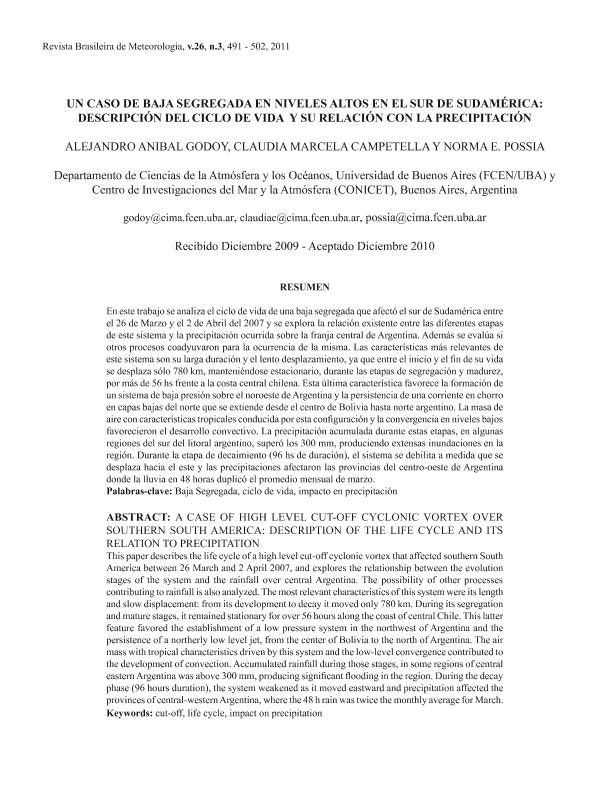Artículo
En este trabajo se analiza el ciclo de vida de una baja segregada que afectó el sur de Sudamérica entre el 26 de Marzo y el 2 de Abril del 2007 y se explora la relación existente entre las diferentes etapas de este sistema y la precipitación ocurrida sobre la franja central de Argentina. Además se evalúa si otros procesos coadyuvaron para la ocurrencia de la misma. Las características más relevantes de este sistema son su larga duración y el lento desplazamiento, ya que entre el inicio y el fin de su vida se desplaza sólo 780 km, manteniéndose estacionario, durante las etapas de segregación y madurez, por más de 56 hs frente a la costa central chilena. Esta última característica favorece la formación de un sistema de baja presión sobre el noroeste de Argentina y la persistencia de una corriente en chorro en capas bajas del norte que se extiende desde el centro de Bolivia hasta norte argentino. La masa de aire con características tropicales conducida por esta configuración y la convergencia en niveles bajos favorecieron el desarrollo convectivo. La precipitación acumulada durante estas etapas, en algunas regiones del sur del litoral argentino, superó los 300 mm, produciendo extensas inundaciones en la región. Durante la etapa de decaimiento (96 hs de duración), el sistema se debilita a medida que se desplaza hacia el este y las precipitaciones afectaron las provincias del centro-oeste de Argentina donde la lluvia en 48 horas duplicó el promedio mensual de marzo. This paper describes the life cycle of a high level cut-off cyclonic vortex that affected southern South America between 26 March and 2 April 2007, and explores the relationship between the evolution stages of the system and the rainfall over central Argentina. The possibility of other processes contributing to rainfall is also analyzed. The most relevant characteristics of this system were its length and slow displacement: from its development to decay it moved only 780 km. During its segregation and mature stages, it remained stationary for over 56 hours along the coast of central Chile. This latter feature favored the establishment of a low pressure system in the northwest of Argentina and the persistence of a northerly low level jet, from the center of Bolivia to the north of Argentina. The air mass with tropical characteristics driven by this system and the low-level convergence contributed to the development of convection. Accumulated rainfall during those stages, in some regions of central eastern Argentina was above 300 mm, producing significant flooding in the region. During the decay phase (96 hours duration), the system weakened as it moved eastward and precipitation affected the provinces of central-western Argentina, where the 48 h rain was twice the monthly average for March.
Un caso de baja segregada en niveles altos en el sur de Sudamérica: descripción del ciclo de vida y su relación con la precipitación
Título:
A case of high level cut-off cyclonic vortex over southern South America: description of the life cycle and its relation to precipitation
Fecha de publicación:
09/2011
Editorial:
Sociedade Brasileira de Meteorologia
Revista:
Revista Brasileira de Meteorologia
ISSN:
0102-7786
e-ISSN:
1982-4351
Idioma:
Español
Tipo de recurso:
Artículo publicado
Clasificación temática:
Resumen
Palabras clave:
Baja Segregada
,
Ciclo de Vida
,
Impacto en Precipitación
Archivos asociados
Licencia
Identificadores
Colecciones
Articulos(CIMA)
Articulos de CENTRO DE INVESTIGACIONES DEL MAR Y LA ATMOSFERA
Articulos de CENTRO DE INVESTIGACIONES DEL MAR Y LA ATMOSFERA
Citación
Godoy, Alejandro Anibal; Campetella, Claudia Marcela; Possia, Norma Edit; Un caso de baja segregada en niveles altos en el sur de Sudamérica: descripción del ciclo de vida y su relación con la precipitación; Sociedade Brasileira de Meteorologia; Revista Brasileira de Meteorologia; 26; 3; 9-2011; 491-503
Compartir
Altmétricas




